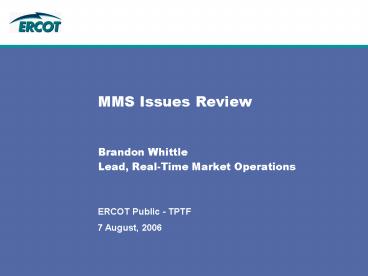MMS Issues Review - PowerPoint PPT Presentation
1 / 7
Title:
MMS Issues Review
Description:
7 August, 2006. ERCOT Public - TPTF. MMS Issues Review. Brandon Whittle ... If SCED issues a base point based on a mitigated offer, is there a requirement ... – PowerPoint PPT presentation
Number of Views:30
Avg rating:3.0/5.0
Title: MMS Issues Review
1
MMS Issues Review
- Brandon Whittle
- Lead, Real-Time Market Operations
2
Notification of Mitigation in SCED
- If SCED issues a base point based on a mitigated
offer, is there a requirement that QSEs be
notified? - If not, is it something to add as a nice-to-have?
3
Use of Combined Cycle Power Augmentation Methods
- Protocol 6.5.5.2 (9)
- A QSE representing combined-cycle Resources shall
provide ERCOT with the possible operating
configurations for each power block with
accompanying limits and price points. Power
augmentation methods must be made available to
ERCOT as part of one or more of the
configurations. Price points for the range of
the curve represented by the power augmentation
method must reflect the price of the added
capability. Such power augmentation methods may
include - (a) Combustion turbine inlet air cooling (CTIAC)
methods - (b) Duct firing
- (c) Other ways of temporarily increasing the
output of combined-cycle Resources and - For QFs, an LSL that represents the minimum
energy available, in MW, from the Resource for
economic dispatch based on the minimum stable
steam delivery to the thermal host plus a
justifiable reliability margin that accounts for
changes in ambient conditions. - Assumption is that this is instructing QSEs to
include these methods when considering their
configuration limits and bids and ERCOT does
provide any specific type of dispatch or
commitment to account for these methods.
4
Use of Generic Incremental Cost for Energy
Dispatch in RUC
- Protocol 5.5.2 (4)
- To determine the projected energy output level of
each Resource and to project potential congestion
patterns for each hour of the RUC, ERCOT shall
calculate proxy Energy Offer Curves based on the
Mitigated Offer Caps for the type of Resource as
specified in Section 4.4.9.4, Mitigated Offer Cap
and Mitigated Offer Floor , for use in the RUC.
Proxy Energy Offer Curves are calculated by
multiplying the Mitigated Offer Cap by a constant
selected by ERCOT from time to time and applying
the cost for all Generation Resource output
between HSL and LSL. The constant selected by
ERCOT may not be more than 0.001. - Multiplying offers by a small constant (.001)
will prevent offers from influencing commitment - ERCOT is concerned that using Mitigated Caps
instead of available Offers will produce a
inaccurate dispatch prediction within RUC
leading to a different set of transmission
constraints than would be present in SCED
5
Energy Offer Curves for RUC Committed Units
- Is a QSE required to submit an Energy Offer Curve
for a RUC committed unit? - If Yes
- This would be consistent with Zonal Protocols
- Would allow Settlement Calculations to be simpler
- Needs to be in Protocols
- If No
- RUC calculation depends on Energy Offer Curve
(through RTAIEC) - Using Proxy Curves developed around Output
Schedule leads to times when it is financially
rewarding for QSEs to not enter offer curve
6
Use of Telemetered Ramp Rate in Real-Time
- Protocols 6.4.5 (1)
- ERCOT shall use the telemetered Resource Status
for all applications requiring status of
Resources during the Operating Hour, including
SCED, Load Frequency Control (LFC), and Network
Security Analysis processes. QSEs shall provide
ERCOT with accurate telemetry of the current
capability of each Resource including the
Resource Status, Ramp Rates, HSL, and LSL and a
text reason for any Resource where a Ramp Rate is
deviating from a standard Ramp Rate curve for the
Resource, or the HSL is less than, or LSL is
greater than, the normal high and low limits set
in Section 3.7.1, Resource Parameter Criteria. - Protocols 6.5.7.1.12
- (c) Normal Ramp Rate by using the curve submitted
by the QSE and the Resources MW telemtery - (d) Emergency Ramp Rate by using the curve
submitted by the QSE and the Resources MW
telemtery - In Protocols 6.5.7.2, SCED ramp rates are
calculated using normal and emergency ramp rates. - What then, is the purpose of having a telemetered
ramp rate? - ERCOT believes that using a telemetered ramp rate
in SCED would be preferable since generation
characteristics can change without timely update
to registration data. - Use of telemetered ramp rates in SCED would
require protocol changes.
7
The End
Questions?































